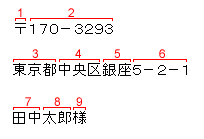Postal services
Post offices provide a range of postal services including the shipping of post cards, letters, parcels and registered mail as well as savings and insurance services. Door-to-door delivery services, known as takuhaibin, are also provided by various companies besides Japan Post.

Small post offices are open Monday to Friday from 9:00 to 17:00 and are closed on weekends and national holidays. Larger offices are opened on weekdays until 19:00 and may also open on Saturdays and Sundays. Most post offices are equipped with ATMs. Mailboxes are red.
Japanese addresses
With the exception of major roads, Japanese streets are not named. Instead, cities and towns are subdivided into areas, subareas and blocks, similar to the insulae system of the Roman empire. To complicate the matter, houses within each subarea were formerly not numbered in geographical sequence but in the temporal order in which they were constructed.
If addresses are written in Japanese, they start with the postal code, followed by the prefecture, city and subarea(s), and end with the recipient's name. If addresses are written in English, they start with the recipient's name and end with the prefecture and postal code. A typical Japanese address looks as follows:

Explanations:

1 - postal symbol: it precedes the postal code.
2 - postal code: it consists of seven digits.
3 - prefecture name: in this case, it is Tokyo.
4 - city, town, village or city ward: in this case, it is Chuo ward.
5 - subarea: in this case, it is Ginza.
6 - further subarea number, block number and house number: in this case, it is subarea 5, block 2, building 1.
7 - last name: in Japan, the last name precedes the first name. In this case, it is Tanaka.
8 - first name: in this case, it is Taro.
9 - title: "sama" is the polite form of "san" and corresponds to "Mr.", "Ms.", etc.
Note that, like all Japanese texts, addresses can also be written in vertical columns from the right to the left instead of in horizontal rows.
Questions? Ask in our forum.